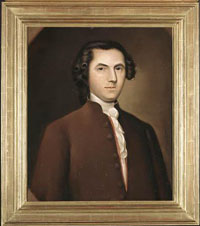Governor: 1711-1712
See also: Edward Hyde, Dictionary of North Carolina Biography

Edward Hyde (1667-1712) was the first Governor of the colony of North Carolina separate and distinct from South Carolina. His brief tenure was dominated by turmoil and violence owing to a revolt led by former governor Thomas Cary and a war with the Tuscarora Indians. The Hyde family was part of the landed gentry and was related to two English monarchs, Queen Mary II and Queen Anne. Hyde was born to Robert Hyde and Phillis Snyed Hyde of Cheshire County, England; however, Hyde was an orphan by the age of three. His grandmother raised Hyde along with his two sisters. Hyde entered Oxford University in 1683 at sixteen, but did not complete his degree. He married Catherine Rigby in 1692. One of Hyde’s contempoaries, William Byrd, referred to Hyde’s wife as an “abundance of life.”
Hyde began his public life when, in 1702, Queen Anne appointed him Jamaica’s provost marshal. Hyde worked at the post from England and found that it gave him no financial security. Hyde and his family left England and arrived in Virginia in August 1710. At first Governor Thomas Cary, who had seized the governorship from William Glover, refused to yield the government to Hyde, who held a commission from the Lords Proprietors. By early 1711, Hyde was in the chief executive office but did not possess the skill necessary to restrain the Anglicans or dissenter factions. In the events growing out of his attempt to overthrow the government, Thomas Cary was arrested and sent to England for trial, but he was eventually freed without receiving any punishment. As a result, Hyde no longer had to contend with Cary, but he faced a greater challenge when Indians rose up against the colonists.
In late September 1711, the Tuscarora and smaller tribes attacked colonists in Bath County in retribution for the recent taking of land along the Neuse, Trent, and Pamlico Rivers and apparently for many years of frustration of being poorly treated by whites. The brutal and destructive attack caught the colonists by surprise, and Hyde faced a serious problem. He was unable to raise a large army because of resentment caused by Cary’s Rebellion and the refusal of Quakers to bear arm or even lend them to others. In this desperate situation, Hyde appealed for help from Virginia and South Carolina. Virginia did not send any troops but South Carolinians, their Indian allies, and some North Carolinians defeated the Tuscarora and negotiated a peace treaty by early 1712. The treaty was not recognized by the assembly and the peace proved to be short-lived. By the summer, the Tuscarora had resumed the war. The Tuscaroras were effectively defeated by a combined force in 1713, but raids continued for several years.
While the conflict with the Indians was raging, the proprietors commissioned Hyde in January 1712 as governor of North Carolina, a chief executive no longer subordinate to a governor in Charles Town South Carolina. Hyde received the commission in May but did not remain governor long enough to enjoy the commission or led troops against the Tuscaroras. On September 8, 1712, Hyde, after suffering for a week, died of yellow fever, a victim of an epidemic that had swept through North Carolina.